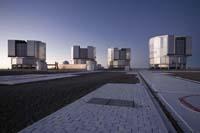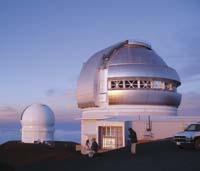Tliltepetl, the house of the millimetric eye

Before building the telescope, the technicians worked hard to find the most appropriate place to build
It seems that the Great Millimeter Telescope looks to the Gulf of Mexico, at the edge of a large mountain in front of the Gulf. But the telescope has been built to focus on space, and the reason is that many millimeter waves of space reach that edge, at least compared to many other parts.
The top of the volcano Tliltepetl is very high, has an appropriate place for the installation of a giant telescope (even for the road to it) and, above all, has a very transparent sky for millimeter waves. Its superior atmosphere is very dry, with little humidity, which is essential for the observation of millimeter waves, which are absorbed by water vapor.
But, optionally, there were other similar suitable places to install the telescope. The Tliltepetl volcano was chosen for being the best, but after many tests. They studied more than ten mountains of more than three thousand meters, including the volcanoes Nevado de Toluca (Xinantecatl, 4.680 m), Cofre de Perote (Nauhcampatepetl, 4.300 m) and La Malinche (Matlalcueyetl, 4.420 m). Mexico's highest volcanoes exceed 5,000 meters (Citlatlaltepetl or Pico de Orizaba 5,610 m, Popocatepetl 5,500 m and Iztaccihuatl 5,220 m), but they were not orographically suitable and no quality tests of the millimeter sky were performed.
Looking for the clean sky
To perform the tests, they had to climb each mountain with tools to measure the transparency of the sky. "Transparency tests are done through a radio meter," explains Itziar Aretxaga. "The radiometer measures the millimeter emission of the atmosphere in a maximum celestial circle (from the zenith to the horizon to form the maximum circle with the earth area on the same plane). As the layers of the upper atmosphere are very cold, they become very powerful millimeter sources, a million times brighter than our distant millimeter galaxies."
Tests are performed in a maximum circle to measure the transparency of radiation from all angles. In fact, the millimeter waves of the stars seen near the horizon must pass through much of the atmosphere than those seen in the zenith.
In addition, they are permanent evidence, since transparency varies according to the time of year. As a result of the measurements, astronomers know that in the dry season (autumn, winter and spring) waves between 0.85 and 4 mm look better, while in the wet season (summer) the atmosphere is transparent for waves between three and four millimeters.



Buletina
Bidali zure helbide elektronikoa eta jaso asteroko buletina zure sarrera-ontzian










